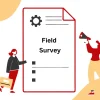
Benefits Of Written Feedback For An Enterprise
Written feedback is vital to personal, professional, and organizational growth. Whether it’s constructive criticism or appreciation, “written feedback” provides clarity, documentation, and opportunities for improvement that are hard to achieve through other methods.
This article dives deep into why written feedback is essential and how it can be used effectively across various domains.
Features of Written Feedback
Written feedback ensures clarity, precision, and thoughtfulness, eliminating ambiguity and minimizing miscommunication. It provides a permanent record for future reference, fostering constructive improvement and clear communication.
1. Clarity and Precision
Written feedback allows thoughts to be conveyed in a clear, organized, and structured manner. Unlike verbal communication, which may involve misunderstandings due to tone or haste, written communication ensures that the message remains consistent.
2. Documentation for Future Reference
Written feedback creates a record that can be revisited whenever necessary. Whether it’s for tracking improvement, preparing for a performance review, or understanding past decisions, having a written record is invaluable.
3. Encourages Thoughtfulness
The process of writing feedback requires deliberation. Unlike spontaneous verbal feedback, written communication compels the author to reflect on their observations and recommendations. This often leads to feedback that is more balanced, specific, and actionable.
4. Minimizes Miscommunication
Verbal communication can sometimes lead to misinterpretations due to variations in tone, body language, or the listener’s frame of mind. Written feedback eliminates these variables, ensuring that the intended message is conveyed with minimal distortion.
Advantages of Written Feedback for Enterprises
Enterprises benefit from written feedback through consistent communication, performance reviews, and improved training programs. It enhances organizational communication, aids in decision-making, and fosters accountability across teams.
1. Consistency Across Teams
In large organizations, written feedback ensures that communication remains consistent across different departments and teams. When managers and team leaders provide structured written feedback, it aligns the organization’s goals and expectations uniformly.
Consistency not only aids in reducing confusion but also strengthens the company culture by ensuring everyone is on the same page.
2. Supports Performance Reviews
Written feedback plays a crucial role in performance evaluations. Quarterly and annual reviews often rely on the detailed feedback that has been documented over time. This allows for a comprehensive understanding of an employee’s progress, achievements, and areas that need improvement.
3. Improves Training and Development
Employees often benefit from detailed written feedback as it serves as a guide for professional growth. By highlighting specific strengths and weaknesses, written feedback enables employees to focus on areas needing development.
4. Enhances Organizational Communication
Written feedback streamlines communication across various levels of an enterprise. Whether it’s through emails, reports, or memos, documenting feedback ensures transparency and clarity in decision-making. It also bridges gaps between departments by providing a shared understanding of goals, issues, and resolutions, fostering collaborative growth.
Tools for Collecting Written Feedback in Enterprises
Tools help to create surveys for structured feedback. Project management platforms like Trello and Asana facilitate task-specific feedback, while Slack and Microsoft Teams streamline real-time written communication and feedback integration.
1. LazyMonkey
LazyMonkey is a robust platform designed for creating detailed surveys with advanced features. It offers pre-built templates tailored for various feedback scenarios, including employee performance reviews, customer satisfaction surveys, and event evaluations.
The platform’s analytics capabilities allow enterprises to assess feedback trends and gain actionable insights. Organizations can also customize surveys with branding elements, which is particularly useful for external feedback collection.
2. Google Forms
Google Forms is an excellent tool for gathering structured feedback. This allow organizations to create customized surveys, including multiple-choice questions, rating scales, and open-text fields. These platforms are highly versatile and can be used to gather feedback on everything from employee satisfaction to project outcomes. .
3. Trello
Trello is a project management tool that doubles as a feedback collection platform. Within these tools, team members can leave comments and suggestions on specific tasks, cards, or projects. This feedback is context-specific and attached to relevant workflows, making it easy to track progress and address concerns in real time.
This platform also supports integrations with other tools, such as Slack or email, to ensure feedback is communicated effectively.
4. Slack
Slack is an essential communication tool for facilitating instant written feedback within teams. Channels, threads, and direct messages provide structured ways to share feedback in real-time or asynchronously. Features such as pinned messages, integration with file storage tools, and automated reminders make it easier to follow up on feedback.
Slack’s casual, chat-based interface encourages open communication.
Comparing Feedback Methods for Organizations
| Types Of Feedback | Advantages | Disadvantages |
|---|---|---|
| Written Feedback | Clear, documented, and thoughtful | May lack immediacy or emotional connection |
| Verbal Feedback | Immediate and personal | Prone to miscommunication and lacks record |
| Anonymous Feedback | Encourages honesty and openness | Can sometimes lack actionable specifics |
| 360-Degree Feedback | Comprehensive and holistic | Time-consuming to implement effectively. |
Conclusion
The benefits of written feedback are a cornerstone of effective communication in personal and professional settings. Its ability to provide clarity, document performance, and guide improvement makes it invaluable. By leveraging written feedback thoughtfully, organizations can foster growth, enhance communication, and achieve better results.
Frequently Asked Questions? (FAQs)
Why Is Written Feedback Better Than Verbal Feedback?
Written feedback offers clarity, serves as a record, and minimizes the risk of miscommunication compared to verbal feedback, which may be forgotten or misinterpreted.
How Often Should Written Feedback Be Provided In The Workplace?
Ideally, written feedback should be provided regularly, such as during performance reviews, after project completions, or whenever constructive input is needed.
What Tools Are Best For Collecting Written Feedback?
Tools like Google Forms, Microsoft Forms, and Slack are popular for collecting written feedback efficiently.
Can Written Feedback Improve Team Collaboration?
Absolutely! Written feedback fosters transparency, helps address issues constructively, and ensures everyone is aligned with team goals.
How Can Written Feedback Be Made More Constructive?
Focus on being specific, actionable, and balanced in your feedback. Highlight both strengths and areas of improvement.
Enhance Patient Care and NABH Compliance with LazyMonkey
LazyMonkey is your all-in-one solution for improving patient care, retaining more patients, and meeting NABH standards. Our powerful QR-based feedback tool enables you to capture real-time insights from patient feedback, discharge surveys, staff and doctor evaluations, and clinical research, while also streamlining inter-departmental communication.
Transform your healthcare facility today - reach out to us at hello@lazymonkey.in, or request a demo here!
Elevate Your Restaurant Experience with LazyMonkey
LazyMonkey’s QR-based feedback system helps you gather real-time insights from customers, track satisfaction levels, and enhance the dining experience. Get instant feedback on your menu, service, and ambience, and make data-driven improvements to boost repeat customers and reviews.
Improve your restaurant today – reach out to us at hello@lazymonkey.in, or request a demo here!
Empower Student Engagement and Campus Improvement with LazyMonkey
LazyMonkey offers a seamless way to gather student feedback, track satisfaction, and enhance campus life. From course evaluations to dorm feedback, our QR-based solution makes it easy to capture valuable insights and improve student retention.
Upgrade your university experience – contact us at hello@lazymonkey.in, or request a demo here!
Streamline Feedback and Drive Performance Across Your Enterprise/Franchise with LazyMonkey
Whether you manage one or multiple locations, LazyMonkey’s QR-based feedback system helps you gather real-time employee and customer feedback. Improve operational efficiency, track satisfaction, and make data-driven decisions to enhance brand consistency and growth.
Transform your franchise today – reach out to us at hello@lazymonkey.in, or request a demo here!
Enhance Customer Satisfaction and Service Standards in Banking with LazyMonkey
LazyMonkey empowers banks to capture real-time feedback from clients across branches. Improve customer experience, assess service quality, and ensure regulatory compliance with our QR-based solution, helping you retain clients and meet banking standards.
Elevate your bank’s customer care – contact us at hello@lazymonkey.in, or request a demo here!
Boost Customer Engagement and Mall Satisfaction with LazyMonkey
LazyMonkey’s QR-based feedback tool enables you to collect feedback from shoppers, track satisfaction, and enhance the mall experience. Gather insights on store services, cleanliness, and entertainment to create an unmatched customer journey.














